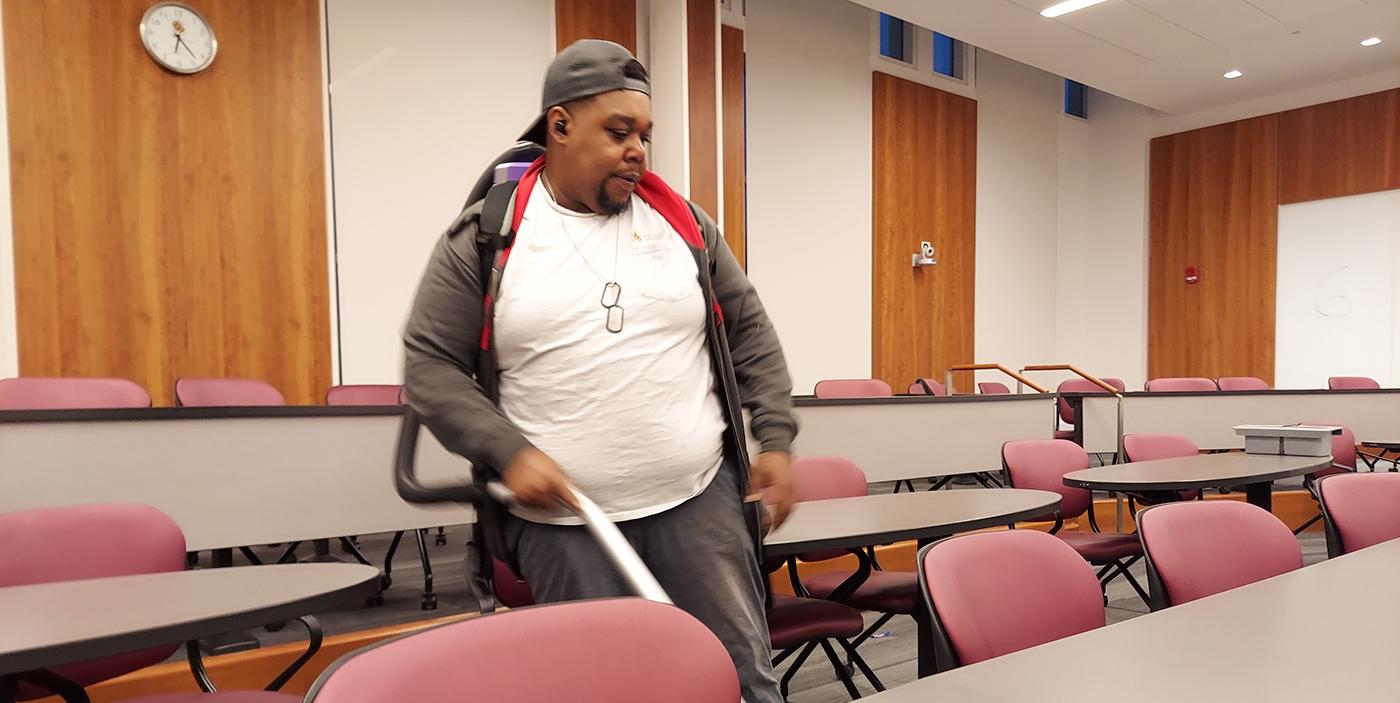
If the thought of vacuuming your living room floor or cleaning your bathroom fills you with dread, consider, for a moment, the work facing Facilities Management’s (FM) Building Services team: Keeping nine million square feet in 100 campus buildings clean and healthy, from top to bottom, every single day. What does it take? How do they do it – day after day?
Organize, Divide and Conquer
Efficiency is key to maintaining a clean and hygienic campus. Building Services housekeeping teams are on the job before most of us are out of bed, working a standard shift that starts at 4 a.m. The campus is split into ten cleaning zones – five to 15 buildings, geographically close together to minimize travel times with 15 to 23 housekeepers assigned to a zone. Within each zone, team members are assigned specific tasks such as dusting or vacuuming. Teams focus on classrooms first so they are ready to use by 8 a.m., then shift to restrooms and other common areas. In addition to more efficient time management, the zone system instills a sense of pride in “their” buildings and allows housekeepers to interact with building occupants.
Pro-tip for home cleaning: Don’t try to clean the whole house in a single stretch. Divide and conquer using the zone method like the pros. Spread tasks throughout the week or over multiple weekends, dividing your home into zones like bedrooms, living room, bathrooms, and kitchen. The frequency used for cleaning each zone will depend on how much time you have to clean as well as the amount of accumulated dust and grime. High-use spaces (like the kitchen) may be cleaned daily while other spaces get addressed only once per month. Your home will be cleaner and you’ll have more time for other activities.
Tools of the Trade: Not Your Grandmother’s Cleaning Products
Modern cleaning is about much more than just keeping dust away. With a focus on maintaining a healthy indoor environment for students, faculty, and staff, FM prioritizes eco-friendly cleaning products and sustainable cleaning practices and meets Green Seal GS-42 standards for health, sustainability, and product performance. UMD was the first state agency to achieve GS-42 certification and only the second university in the nation to meet this standard five years ago.
What else is on the pro’s cleaning cart? Feather dusters are out, replaced by microfiber products - for dusting, wiping countertops, cleaning mirrors, and mopping floors. While brooms, mops, and traditional vacuums are still part of the job, some floor teams get support from robot floor scrubbers. The autonomous cleaners reduce labor and cleaning time while achieving a deeper clean. The two battery-operated units in the Edward St.John Learning and Teaching Center and the John S. Toll Physics Building use less water than traditional floor scrubbers and can run for five hours.
Pro-tip for home cleaning: Use microfiber products for home cleaning tasks. This modern cleaning resource is lint-free, absorbent, durable, and requires fewer (or no) chemicals to get the job done. Maintain a healthy indoor home environment with eco-friendly cleaning products (available everywhere) that meet the EPA’s Safer Choice Standard. Save time and effort with a home autonomous vacuum or floor cleaner. Robot floor cleaners can tackle a variety of tasks – sweeping, mopping, and UV sterilization and can be programmed to work while you’re away.
Staying Safe on the Job
While most of us wouldn’t consider cleaning a dangerous job, the Occupational Safety and Health Administration (OSHA) might disagree. In fact, cleaning hazards are a normal part of the job. Thankfully, there are ways to minimize those risks and still get the job done. Personal protective equipment (PPE) helps ensure that housekeepers are safe on the job, including non-slip shoes to reduce the risk of slips, trips, and falls, and gloves and masks to prevent skin contact with chemicals and inhalation of dangerous vapors. Though not as common as other hazards, exposure to bloodborne pathogens and other bodily fluids present the most dangerous of on-the-job risks. UMD housekeepers receive specialized training on OSHA-established standards for occupational practices and rely on PPE and robust disinfectants for protection.
Pro-tip for home cleaning: Home cleaning may not involve the same risks that the pros face, but everyone can benefit from safe practices and the use of PPE. Be sure to read cleaning supply labels and manuals that come with appliances. Stay alert and present, and use step ladders with caution for reaching high places, Be sure to put away electrical cords immediately after use. Household cleaners, even mild ones, can be irritating or harmful in contact with skin or eyes. Gloves and eye protection will ensure you stay safe and a mask will protect you from harmful fumes.
Whether your home is 700 sq, feet or 7000, use these pro tips to keep your home as healthy and clean as UMD in a fraction of the time.
